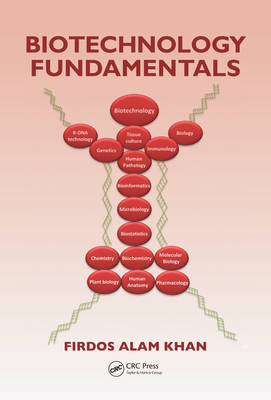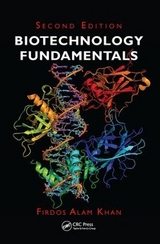
Biotechnology Fundamentals
Crc Press Inc (Verlag)
978-1-4398-2009-4 (ISBN)
- Titel erscheint in neuer Auflage
- Artikel merken
Keeping pace with the rapid advancement of the field, topics covered include:
How biotechnology products are produced
Differences between scientific research conducted in universities and industry
Which areas of biotechnology offer the best and most challenging career opportunities
Key laboratory techniques and protocols employed in the field
The contents of this book are derived from discussions between teachers and undergraduate students and designed to address the concepts and methods thought useful by both sides. Starting with the fundamentals of biotechnology, coverage includes definitions, historical perspectives, timelines, and major discoveries, in addition to products, research and development, career prospects, ethical issues, and future trends.
The author explains that even before it had been classified as its own field, biotechnology was already being applied in plant breeding, in vitro fertilization, alcohol fermentation, and other areas. He then delves into new developments in areas including stem cell research, cloning, biofuels, transgenic plants, genetically modified food/crops, pharmacogenomics, and nanobiotechnology. Incorporating extensive pedagogy into the content, this book provides plenty of examples, end-of-chapter problems, case studies, and lab tutorials to help reinforce understanding.
Dr. Firdos Alam Khan is chairperson of the department of biotechnology at Manipal University in Dubai. He received his doctoral degree in the field of neuroscience from Nagpur University, India and has more than 15 years of research and teaching experience in various domains of biotechnology. His area of specialty in biotechnology includes stem cell technology, pharmacology, and neuroscience. He did his first postdoctoral research from Tata Institute of Fundamental Research, Mumbai, India and his second postdoctoral training from Massachusetts Institute of Technology (MIT), Cambridge, USA. He also worked with Long Beach Memorial Medical Center, California, USA on a Parkinson’s’ research project. He later joined Reliance Life Sciences Mumbai, India and worked on adult and embryonic stem cell projects. He has written numerous articles in various national and international journals in the areas of neuroscience, neuropharmcology and stem cell biology. He has filed several patents in the field of stem cell technology in India, Europe, and USA, and he has been associated with international scientific organizations including the International Brain Research Organization in France and the Society for Neuroscience in the U.S. He has also been a presenter at more than 20 different international conferences in places including India, China, Thailand, and the United States.
Introduction to Biotechnology
What Is Biotechnology?
Animal Biotechnology
Agricultural Biotechnology
Medical Biotechnology
Industrial Biotechnology
Environmental Biotechnology
Other Emerging Fields of Biotechnology
History of Biotechnology
Human Genome Project
Major Scientific Discoveries in Biotechnology
Biotechnology as the Science of Integration
Bio-Revolution
Ethical and Regulatory Issues in Biotechnology
Future of Biotechnology
Genes and Genomics
Introduction
Cell as the Building Block of Life
Classification of Cells
Extracellular Organization
Intracellular Organization
Macromolecules
Genes and Genetics
Cell Division
DNA Replication
DNA Interactions with Proteins
DNA-Modifying Enzymes
DNA Methylation
DNA Mutation
Tools of Biotechnology
Proteins and Proteomics
Introduction
Significance of Proteins
Protein Biosynthesis
Protein Structure
Protein Folding
Protein Modification
Protein Transport
Protein Dysfunction and Degradation
Regulation of Protein Synthesis
Regulatory Protein
Methods for Protein Analysis
Protein Purification
Tools of Proteomics
Recombinant DNA Technology
Introduction
Making of Recombinant DNA
Significance of Recombinant DNA Technology
Role of Restriction Enzymes in rDNA Technology
Steps in Gene Cloning
Synthesis of Complete Gene
Polymerase Chain Reaction and Gene Cloning
Significance of Vectors in rDNA Technology
Classification of Vectors
Integration of the DNA Insert into the Vector
Introduction of the Recombinant DNA into the Suitable Host
Increased Competence of E. coli by CaCl2 Treatment
Infection by Recombinant DNAs Packaged as Virions
Selection of Recombinant Clones
Identification of Clones Having Recombinant DNAs
Selection of Clone Containing a Specific DNA Insert
Applications of Recombinant DNA Technology
DNA Sequencing
Microarrays
DNA Chips
Isolation of Desired DNA
cDNA Library
Preparation of cDNA
Genomic Library
DNA Libraries
Chemical Synthesis Gene
Applications of Synthetic Oligonucleotides
Microbial Biotechnology
Introduction
Structural Organization of Microbes
Microbial Metabolism
Microbial Growth
Microbial Genetics
Genetic Recombination in Bacteria
Transposable Genetic Elements
Use of E. coli in Microbial Cloning
Pathogenic Bacteria
Application of Microbes
Food Microbiology
Microbial Biotechnology
Agricultural Biotechnology
Introduction
Plant Breeding
Plant Diseases
Applications of Molecular and Genetic Tools in Agriculture
Herbicide-Tolerant Plants
Pigmentation in Transgenic Plants
Altering the Food Content of Plants
Gene Transfer Methods in Plants
Target Cells for Gene Transformation
Vectors for Gene Transfer
Transformation Techniques Using Agrobacterium
ß-Glucuronidase GUS Gene
Agroinfection and Gene Transfer
DNA-Mediated Gene Transfer
Electroporation for Gene Transfer
Liposome-Mediated Gene Transfer
Gene Transformation Using Pollen
Application of Transgenic Plants
How Safe Are Transgenic Plants?
Bioengineered Plants
Genetically Modified Maize
Terminator Technology
Animal Biotechnology
Introduction
History of the Use of Animals in Research
Drug Testing in Animals is Mandatory
Application of Animal Models
Animal Models
Animal Biotechnology
Biotechnology and Fish Farming
Regulations of Animal Testing
Environmental Biotechnology
Introduction
Factors Affecting the Environment
Environment Protection by Biotechnology
Medical Biotechnology
Introduction
Antibody Production
Therapeutic Proteins
Stem Cell Transplantation
Bioengineered Skin
Bioengineered Organ Transplantation
Gene Therapy
Molecular Diagnostics
Artificial Blood
Organ Transplant
Cloning
Nanobiotechnology
Introduction
Nanotechnology
Nanobiotechnology
Applications of Nanobiotechnology
Nanotechnology in the Food Industry
Water Pollution and Nanotechnology
Research Trends
Product Development in Biotechnology
Introduction
Methods of Scientific Enquiry
Commercialization of Scientific Discovery
Business Plan
Biotechnology Product Development
Phases of Biotechnology Product Development
Biotechnology Entrepreneurship
Biotechnology Industry: History and Facts
Formation of a New Biotechnology Company
Successful Bioentrepreneurship
Biotechnology Products and Intellectual Property Rights
Biotechnology Stock Investment: Pros and Cons
Marketing Trends in Biotechnology
Role of Regulators in Biotechnology Product Development
Certification and Accreditation
Industrial Biotechnology
Introduction
Fermenter or Bioreactor
Principle of Fermentation
Production of Biomolecules Using Fermenter Technology
Development Process of Microbial Products
Upstream Bioprocess
Downstream Bioprocess
Bioprocess Automation
Industrial Application of Microbes
Industrial Production of Healthcare Products
Ethics in Biotechnology
Introduction
Genetically Modified Foods and Plants
Use of Animals as Experimental Models
Use of Humans as Experimental Models
Xenotransplantation
Genetic Screening
Biometrics
DNA Fingerprinting
Organ Donation and Transplantation
Euthanasia
Neuroethics
Assisted Reproductive Technology
Embryonic Stem Cell Research
Human Cloning
Careers in Biotechnology
Introduction
Education and Investment in Biotechnology
Research and Development in Biotechnology
Biotechnology Industry and Products
Biotechnology Status in the United States
Career Opportunities in Biotechnology
Entry-Level Job Positions in Biotechnology
Administration
Which Job Is Good for Me?
Why Are R&D Jobs the Most Challenging?
Salary and Incentives in Biotechnology
Laboratory Tutorials
Laboratory Experiments
Laboratory Safety
Good Laboratory Practices for Biotechnology Labs
General Laboratory Techniques
General Principles of Animal Handling
Animal Anesthesia
Animal Histology
Blood Collection in Animals
Histology and Microscopy
Separation Techniques
Microbiology Techniques
Biochemistry Techniques
Molecular Techniques
Genetic Techniques
Agricultural Biotechnology
Microbial Biotechnology
Glossary
| Zusatzinfo | N/A; N/A; 16 Tables, black and white; 148 Illustrations, black and white |
|---|---|
| Verlagsort | Bosa Roca |
| Sprache | englisch |
| Maße | 178 x 254 mm |
| Gewicht | 1429 g |
| Themenwelt | Medizin / Pharmazie ► Medizinische Fachgebiete ► Pharmakologie / Pharmakotherapie |
| Naturwissenschaften ► Biologie | |
| Technik ► Umwelttechnik / Biotechnologie | |
| ISBN-10 | 1-4398-2009-0 / 1439820090 |
| ISBN-13 | 978-1-4398-2009-4 / 9781439820094 |
| Zustand | Neuware |
| Haben Sie eine Frage zum Produkt? |
aus dem Bereich



